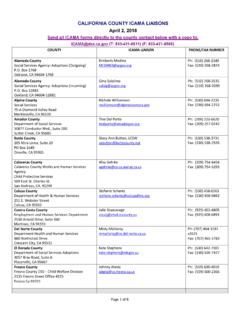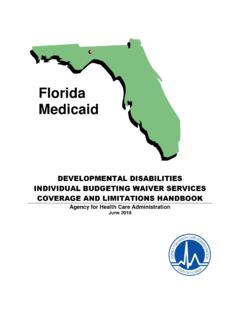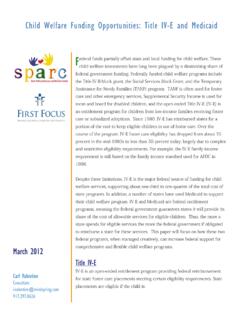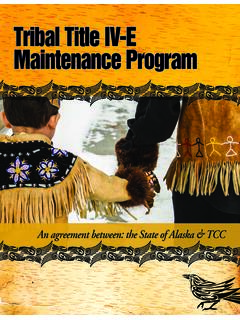Transcription of Medicaid for Title IV-E and Non Title IV-E Adoption Assistance
1 Medicaid for Title IV-E and Non- Title IV-E AA. Making Medicaid Happen: Medicaid for Title IV-E and Non Title IV-E. Adoption p Assistance Sharon McCartney, JD, AAICAMA Consultant The Association of Administrators of the Interstate Compact on Adoption and Medical Assistance (AAICAMA). Oakland, California March 2016. California County Training 2016 by AAICAMA. All rights reserved. Medicaid for Title IV-E and Non- Title IV-E AA. Making Medicaid Happen: Title XIX. for Title IV-E. Adoption Assistance Association of Administrators on the Interstate Compact on Adoption and Medical Assistance - AAICAMA. Medicaid Presentation Points Medical Assistance and placement success - data and statistics Medicaid - facts, eligibility, supremacy of federal law, residency Medicaid services - types, types limitations, limitations EPSDT. Receiving Medicaid services - differences between Title IV-E. populations; ICAMA. Open O discussion di i State St t and d county t practices ti Association of Administrators on the Interstate Compact on Adoption and Medical Assistance - AAICAMA.
2 3. Question Question: How important is Medicaid to children eligible for Adoption Assistance ? Answer: Very important. Association of Administrators on the Interstate Compact on Adoption and Medical Assistance - AAICAMA. 4. Data and Statistics Quote: 'While there have not been systematic national studies of the prevalence of disability among children in foster care, individual studies in various states and localities have highlighted a range of potential challenges. These studies have found the following: 40% born low birth weight or premature 80% prenatally exposed to substances 30-80% with at least one chronic medical condition [ asthma, HIV, TB]. 30-50% with dental decay 25% with three or more chronic health problems 30-60% with developmental delays 50-80% with mental and behavioral health problems 20% fully handicapped 30-40% receiving special education services.'. Cite: A Case for Action for Children and Youth with Disabilities in Foster Care, A Project of United Cerebral Palsy and Rights, 2006 (Multiple citations).
3 Children'ss Rights Children Association of Administrators on the Interstate Compact on Adoption and Medical Assistance - AAICAMA. 5. Medicaid Facts Medicaid was established in 1965. Medicaid is a partnership between the federal government and the states jointly states jointly funded (FMAP), (FMAP) operated by the states states, and overseen by the Centers for Medicare & Medicaid Services (CMS). Medicaid is a major source of funding for medical and health- related services for limited income families and individuals. individuals Association of Administrators on the Interstate Compact on Adoption and Medical Assistance - AAICAMA. 6. Medicaid Eligibility Medicaid eligibility is by category'. Title IV-E eligible children are referred to as categorically eligible' to receive i Medicaid M di id as mandatory d t categorically t i ll needy'. d '. Citations: The Federal law on this subject can be found in the United States Code ( ), (U S C ) the Social Security Act (SSA), (SSA) and the Code of Federal Regulations (C.)
4 ( ). FR). at the following citations: 42 673 (b)(1) [found also at Section 473 (b)(1) of the Social Security Act]. 42 1396a (10)(A)(i)(I) [found also at Section 1902a (10)(A)(i)(I) of the Social Security Act]. 42 Association of Administrators on the Interstate Compact on Adoption and Medical Assistance - AAICAMA. 7. Mandatory Eligibility: Title IV-E = Medicaid The effect of the federal law: The AFDC look-back provision to Title IV-E means Title IV-E eligible children are treated like AFDC eligible children were for the purposes of Medicaid eligibility eligibility is automatic. Note: This remains true after 110-351, Fostering Connections to Success and Increasing Adoptions Act of 2008. States must provide Medicaid to Title IV-E eligible children for whom foster care maintenance payments are made, a valid Adoption Assistance agreement exists, or a subsidized guardianship under an active ti Title titl IV-E. IV E waiver i or subsidized b idi d relative l ti guardianship di hi exists i t for f which Assistance payments are made (GAP).
5 Cit 42 Cite: U S C 1396a 1396 a)(10)(A)(ii)(I). )(10)(A)(ii)(I). Association of Administrators on the Interstate Compact on Adoption and Medical Assistance - AAICAMA. 8. Medicaid & Residency State of residence. Medicaid is received through a child's state of residence. Cite: 42 C F R 435 403 (g). (g). Association of Administrators on the Interstate Compact on Adoption and Medical Assistance - AAICAMA. 9. Residency The effect of the federal law: For children receiving Title IV-E, the state of residence is defined as the state where the child lives'. The physical presence of a Title IV-E. eligible child in a state triggers* state responsibility for the provision off M. Medicaid di id to t the th child. hild * Temporary absences from the state Cite: 42 1392a (16). Association of Administrators on the Interstate Compact on Adoption and Medical Assistance - AAICAMA. 10. Residency The effect of the federal law: Residence is the controlling factor in determining state responsibility for the provision of Medicaid .
6 Title IV-E foster care and guardian Assistance : State of residence id provides id Medicaid , M di id however, h maintenance i t paymentst must be made in order for the child to be eligible to receive Medicaid . Title IV-E Adoption Assistance : State of residence provides Medicaid , however, maintenance payments do not have to be made for a child to be eligible to receive Medicaid . Association of Administrators on the Interstate Compact on Adoption and Medical Assistance - AAICAMA. 11. Residency and Out of State Residential Facilities The CMS defines living' to include a stay in a school, an inpatient psychiatric facility, psychiatric hospital, or psychiatric unit of a general hospital. g p The state in which the facility or school is located is responsible for the provision of Medicaid to Title IV-E eligible g children for the length of their in-patient treatment or academic stay. Cite: Clarification Letter to AAICAMA from the Centers for Medicare and Medicaid Services, 2001.
7 Association of Administrators on the Interstate Compact on Adoption and Medical Assistance - AAICAMA. 12. Questions Is there any limit to what states must provide under Medicaid ? What Medicaid services must states provide? p What Medicaid services can states elect to provide? How can a placement professional secure a Medicaid service for a Medicaid eligible child if the service is not covered in the resident state's Medicaid State Plan? Association of Administrators on the Interstate Compact on Adoption and Medical Assistance - AAICAMA. 13. Medicaid Services There are two broad categories of Medicaid services: Mandatory services Optional services Association of Administrators on the Interstate Compact on Adoption and Medical Assistance - AAICAMA. 14. Mandatory Services Physician services In-patient and out-patient hospital Medical and surgical dental EPSDT. Laboratory L b t and d x-ray Rural health clinic services Association of Administrators on the Interstate Compact on Adoption and Medical Assistance - AAICAMA.
8 15. Optional Services Optometrists'. O t ti t 'S. Services i Prescription P esc iption D. Drugs gs Psychiatric Care Eyeglasses (Psychologists/Psychiatrists' Diagnostic Services S i ). Services) S. Screening i Services S i Private Duty Nursing Preventive Services Clinic Services Rehabilitative Services Dental Services Emergency Hospitall Services Occupational Therapy Nursing Facilities Services for Under Age 21. Speech Hearing and Speech, Language Therapy Association of Administrators on the Interstate Compact on Adoption and Medical Assistance - AAICAMA. 16. Medicaid Coverage There are some limits to state responsibility for the provision of Medicaid . Cite: 42 1396a and 42 1396d . Association of Administrators on the Interstate Compact on Adoption and Medical Assistance - AAICAMA. 17. Medicaid Coverage Th effect The ff t off th the ffederal d l llaw: States must provide Medicaid to eligible children through the minimum age of 18* and states must provide federally defined mandatory' Medicaid services.
9 *age of 19 for some categories States can optionally provide Title IV-E up to the age of 21. States must provide Medicaid to the age that the Assistance state's eligibility program provides Medicaid . States can decide which optional Medicaid services to provide provide. Note: States must provide Medicaid to Title IV-E recipients under the age of 21. Association of Administrators on the Interstate Compact on Adoption and Medical Assistance - AAICAMA. 18. EPSDT. Early - Assessing a child's health early in life so potential diseases and disabilities can be prevented or detected in the early stages when they can be most effectively treated treated. Periodic - Assessing a child's health at key points in her/his life to assure continued healthy development. Screening - Using tests and procedures to determine if children being examined have conditions requiring closer medical (including mental health) or dental attention. Diagnosis - Determining the nature and cause of conditions id tifi d by identified b screenings i andd those th that th t require i further f th attention.
10 Tt ti Treatment - Providing services needed to control, correct, or reduce physical and mental health problems. Association of Administrators on the Interstate Compact on Adoption and Medical Assistance - AAICAMA. 19. Securing Medicaid Services EPSDT provides a mechanism for children to receive services determined medically necessary and allowed under Medicaid , even if not included in a state's Medicaid plan. p EPSDT provides an avenue for securing Medicaid services when the resident state's State Medicaid Plan does not p provide a requested q service and/or provides different coverage of a provided service. Association of Administrators on the Interstate Compact on Adoption and Medical Assistance - AAICAMA. 20. Receiving Medicaid Services Title IV-E Adoption Assistance The ICAMA: The Interstate Compact on Adoption and Medical Assistance ICAMA Form Cite: 42 675 (3)(B). Association of Administrators on the Interstate Compact on Adoption and Medical Assistance - AAICAMA.










